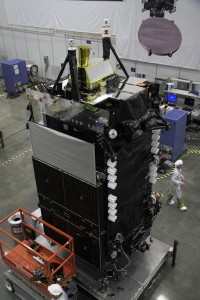ANALYSIS: Avoiding the China comsat trap
You know the legislative season is in full swing when the annual tough talk about China morphs into bill language. Wording in the House version of the National Defense Authorization Act would require gobs of paperwork – including an assessment by the director of national intelligence -- before the military ever again leases satellite bandwidth from a company owned partly by China. For good measure, the bill tosses in North Korea and any countries on the U.S. list of state sponsors of terrorism.
The wording sprang from news earlier this year that the U.S. military needed more satellite coverage in Africa, so it indirectly leased capacity from a satellite owned partly by China.
Underlying this controversy is a bit of acquisition bureaucracy that will probably never make a Tom Clancy novel. The U.S. pays for commercial bandwidth under a complicated approach that treats commercial satcom as a service that can be lined up whenever the military finds itself in a pinch.
Those who don’t like that approach, including retired Air Force Brig. Gen. Tip Osterthaler, are seizing the China satcom controversy as an opportunity to argue for a new way of doing business.
Osterthaler is CEO of SES Government Solutions of McLean, Va. His company exists to lease satcom capacity to the Defense Department and other U.S. agencies from a fleet of commercial satellites operated by SES of Luxembourg.
Today, the U.S. General Services Administration and the Defense Information Systems Agency jointly maintain two lists of approved satcom providers under an initiative called the Future Comsatcom Services Acquisition. One list is used for leasing bandwidth, and it's known as SIN 54, short for special item number 54. The other list, SIN 55, has 29 companies, and it’s for subscription services. Some companies are on both lists, including Osterthaler’s.
SES and other companies are making good money, but the downside in Ostherthaler’s view is that good commercial solutions aren't always available to the government.
“As long as you’re buying satcom out of IDIQ contracts” – multi-year indefinite delivery/indefinite quantity agreements – “you’re necessarily buying out of existing inventory, and you’re stuck with whatever is on the menu,” he says.
When the White House decided to get serious about countering Islamic militants in Africa last year, the best choice on the comsat menu was a satellite called Apstar 7. It’s parked in geosynchronous orbit over the Indian Ocean, and is operated by APT Satellite Holdings of Hong Kong. APT is 36 percent owned by the Chinese government’s China Aerospace Science and Technology Corporation.
APT isn’t one of the Defense Department's approved contractors, but a company called Harris Caprock of Fairfax, Va., is. Harris Caprock doesn’t own or operate any satellites. It leases raw capacity from fleet operators and incorporates that capacity into end-to-end communications offerings. Harris Caprock arranged for military communications to flow over Apstar 7 as part of its successful Africa comms bid. In a prepared statement, the company says all its offerings must meet the Defense Department’s “stringent information assurance standards.”
For its part, APT insists its satellites aren’t controlled by China: “We are a separate, independent corporation; we operate independently,” says Brian Lo, APT’s spokesman. That’s a tough sell to lawmakers alarmed by China’s alleged cyber espionage and theft of intellectual property.
In Osterthaler’s view, the risk to the U.S. isn’t so much that China could eavesdrop on military comms. Any sensitive U.S. information flowing over Apstar 7’s transponders would be sent as heavily encrypted streams of ones and zeros. The bigger risk is that China could gain leverage in a political or military crisis by using its influence over APT’s transponders to say, “Just shut 'em down, take them off the air,” Osterthaler says.
The Apstar 7 issue was thrust onto the public record during an April hearing, when Rep. Mike Rogers, an Alabama Republican, asked a Pentagon official about any agreements “in which the People’s Republic of China has significant ownership interest.”
Doug Loverro, the deputy assistant secretary of defense for space policy, said he learned about the China satcom leases only when he arrived at his new position about a month earlier.
Osterthaler thinks he knows how the Pentagon can avoid ending up on the hotseat again. He wants the military to throw out the services approach for satcom in favor of integrating the commercial players into its long-term communications planning.
“We’re going around and around on how to improve the way we acquire services,” Osterthaler says. “Even if we fix services, it’s going to take a long time, it’s going to be imprecise, and it might not even be broken” for things like “pencils” and “janitorial services,” he says.
Osterthaler wants the Defense Department to be given the authority to tell satellite operators how much throughput they expect to need in future years in specific geographic regions. Commercial satcom providers could then compete to satisfy that demand.
Government antennas could be installed on new commercial satellites as hosted payloads. Free-flying small satellites could be built for government use. Exclusive access could be offered to steerable beams that boost capacity where it’s needed.
Here’s the tricky part: “The common feature of all of these kinds of arrangements is that the Department would actually have to make a commitment in order for the commercial satellite company to make the investment,” Osterthaler says.
If nothing is done, he thinks Congress and the Pentagon will end up with more Apstar 7-like dilemmas.
“We’d probably all be surprised if we looked at the number of times that contracts were awarded on satellites that people might think ought to be subject to review, oversight and limitation,” he says. “If we don’t like that, we need to pursue some logical alternatives so we can get out of this situation that we’re in.”




The Deep Dive Intelligence discussion on the debate revolving around the DoD’s recent purchase of satellite capacity from a Chinese company helps to focus on the key issue: the U.S. military buys commercial satellite bandwidth with a process that inevitably increases costs and that supposes commercial providers will have a perennial supply of capacity for the military.
XTAR applauds efforts from OSD to engage trusted commercial satellite operators who have supported the military for years. Through true collaboration – where both parties are in close dialogue during planning and execution – we can change acquisition policy into a sensible and sustainable long-term buying process. The DoD will finally enjoy well-planned, cost-effective and high utility commercial satellite resources.
Let’s make this a reality for our warfighters and our national security.